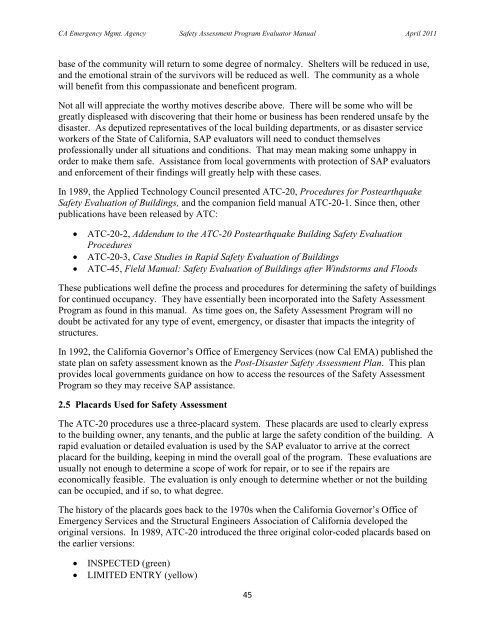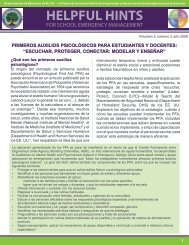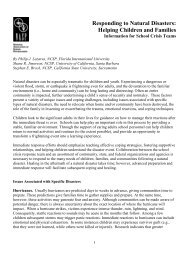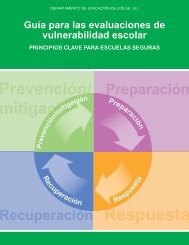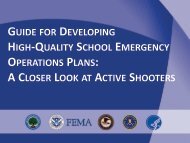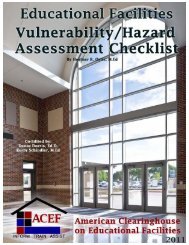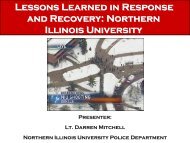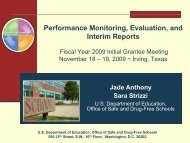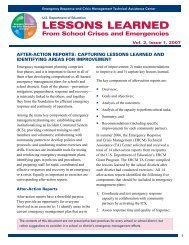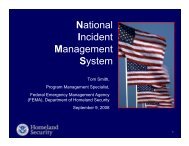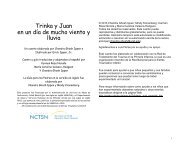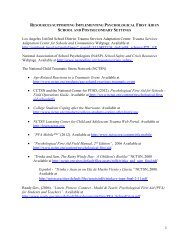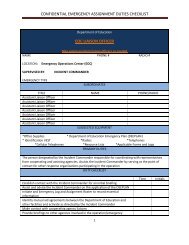Safety Assessment Program Evaluator Student Manual
Safety Assessment Program Evaluator Student Manual
Safety Assessment Program Evaluator Student Manual
Create successful ePaper yourself
Turn your PDF publications into a flip-book with our unique Google optimized e-Paper software.
CA Emergency Mgmt. Agency <strong>Safety</strong> <strong>Assessment</strong> <strong>Program</strong> <strong>Evaluator</strong> <strong>Manual</strong> April 2011base of the community will return to some degree of normalcy. Shelters will be reduced in use,and the emotional strain of the survivors will be reduced as well. The community as a wholewill benefit from this compassionate and beneficent program.Not all will appreciate the worthy motives describe above. There will be some who will begreatly displeased with discovering that their home or business has been rendered unsafe by thedisaster. As deputized representatives of the local building departments, or as disaster serviceworkers of the State of California, SAP evaluators will need to conduct themselvesprofessionally under all situations and conditions. That may mean making some unhappy inorder to make them safe. Assistance from local governments with protection of SAP evaluatorsand enforcement of their findings will greatly help with these cases.In 1989, the Applied Technology Council presented ATC-20, Procedures for Postearthquake<strong>Safety</strong> Evaluation of Buildings, and the companion field manual ATC-20-1. Since then, otherpublications have been released by ATC:ATC-20-2, Addendum to the ATC-20 Postearthquake Building <strong>Safety</strong> EvaluationProceduresATC-20-3, Case Studies in Rapid <strong>Safety</strong> Evaluation of BuildingsATC-45, Field <strong>Manual</strong>: <strong>Safety</strong> Evaluation of Buildings after Windstorms and FloodsThese publications well define the process and procedures for determining the safety of buildingsfor continued occupancy. They have essentially been incorporated into the <strong>Safety</strong> <strong>Assessment</strong><strong>Program</strong> as found in this manual. As time goes on, the <strong>Safety</strong> <strong>Assessment</strong> <strong>Program</strong> will nodoubt be activated for any type of event, emergency, or disaster that impacts the integrity ofstructures.In 1992, the California Governor‟s Office of Emergency Services (now Cal EMA) published thestate plan on safety assessment known as the Post-Disaster <strong>Safety</strong> <strong>Assessment</strong> Plan. This planprovides local governments guidance on how to access the resources of the <strong>Safety</strong> <strong>Assessment</strong><strong>Program</strong> so they may receive SAP assistance.2.5 Placards Used for <strong>Safety</strong> <strong>Assessment</strong>The ATC-20 procedures use a three-placard system. These placards are used to clearly expressto the building owner, any tenants, and the public at large the safety condition of the building. Arapid evaluation or detailed evaluation is used by the SAP evaluator to arrive at the correctplacard for the building, keeping in mind the overall goal of the program. These evaluations areusually not enough to determine a scope of work for repair, or to see if the repairs areeconomically feasible. The evaluation is only enough to determine whether or not the buildingcan be occupied, and if so, to what degree.The history of the placards goes back to the 1970s when the California Governor‟s Office ofEmergency Services and the Structural Engineers Association of California developed theoriginal versions. In 1989, ATC-20 introduced the three original color-coded placards based onthe earlier versions:INSPECTED (green)LIMITED ENTRY (yellow)45


